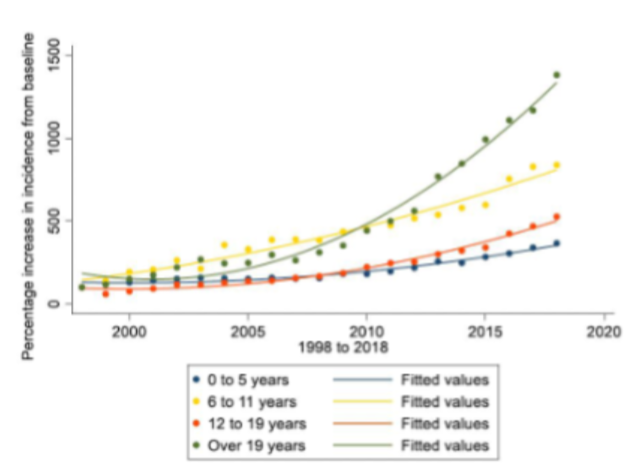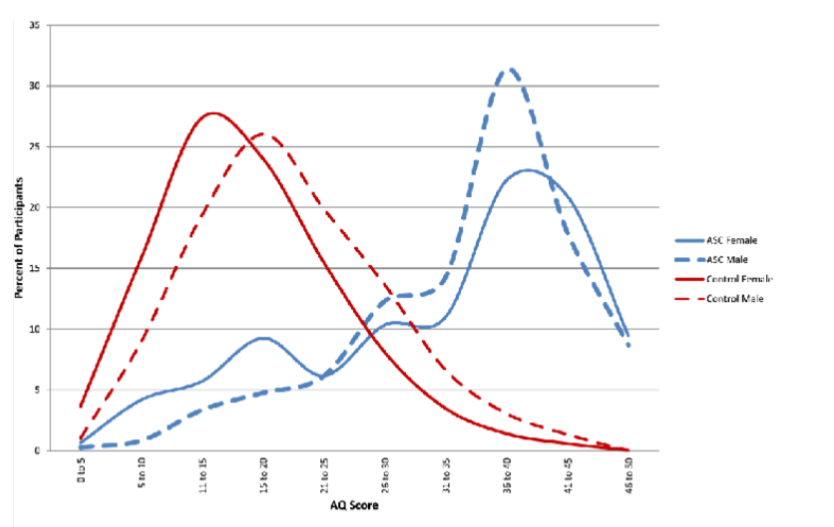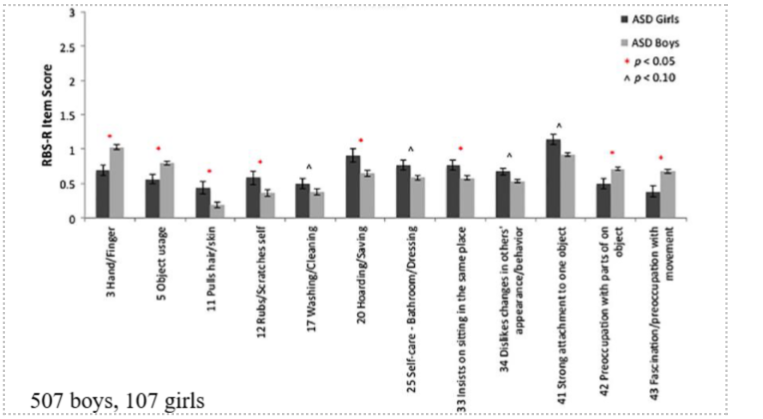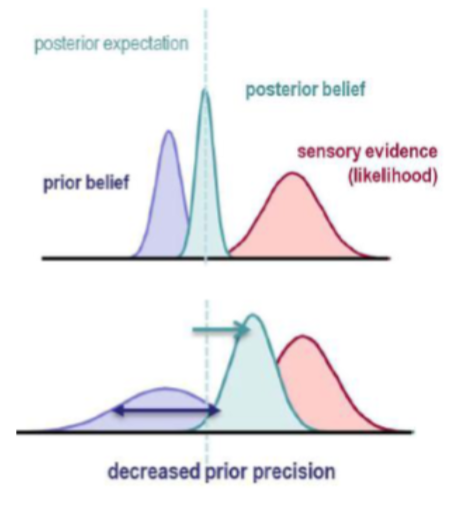PBS6: Autism
1/66
There's no tags or description
Looks like no tags are added yet.
Name | Mastery | Learn | Test | Matching | Spaced |
|---|
No study sessions yet.
67 Terms
Havdahl et al. (2021)
Review of genetics research - Risk of autism likely due to common inherited genes acting on mass but individually having a small effect.
Rare genetic variation has large effect sizes but low population risk – 10% of ASD’s diagnosed with a rare diagnostic disorder.
Schendel and Thorsteinsson (2018)
The prevalence of autism is increasing drastically, graph showing the age at which people are diagnosed, with the cumulative incidences of diagnoses, looking at birth cohorts
There is no evidence that there are systematic environmental factors which are changing the prevalence of autism
Increase is much shaper for females than males.

Baron-Cohen (2014) -The Autism Spectrum Quotient
Important not to think of autism as a binary diagnostic criterion, people may have traits of autism, but this doesn't mean that they meet autistic diagnostic criteria.
There are small amounts of overlap in autistic traits between those that reach clinical threshold and those that don’t

Sandin et al. (2014)
Conducted a population cohort study, to estimate heritability, using relative recurrence risk (RRR).
increasing levels of shared DNA, increased the chances of having autism
MZ twins (100% shared), the RRR was 153, compared to 8.2 RRR for DZ (50% shared).
Only 2.0 RRR between cousins, who share as little as 12.5% of their DNA
SNP’s
Single Nucleotide Polymorphisms - common variants, each individual SNP may increase or decrease your likelihood for autism by small amounts, however when these are combined, they have a much larger effect
SNV’s
De Novo genetic mutations - appear for the first time in an individual, not inherited from the parent
Fu et al. (2022)
Genomic sequencing comparing the genetics of autistic versus non-autistic individuals.
NRXN1 – important for synapse formation, associated with autism quite strongly, responsible for maintaining contact between pre and post synaptic terminals
Variations in NRXN1 do not only cause autism – 10% have autism, 50% have epilepsy etc
Lyall et al. (2011)
Longitudinal study following the lives of nurses. Find a significant association between the BMI of nurses at age 18 and the increased likelihood of having an autistic child
Association could be mediated through other factors e.g. mothers could be autistic themselves, and have food sensitivities, or could experience mental illness that impacts diet/activity
Study was completed several years ago when less was known about autism in women.
Taylor et al. (2019)
looked at the mutation rates in fathers across a range of conditions – all of the fathers tended to have more de novo mutations
But older fathers have a larger likelihood of autism than is predicted from the de novo model
Rotem et al. (2021)
Looked at the relationship between PCOS and autism in a cohort of children born between 1999 and 2013. Found that children of mothers with PCOS had higher ASD odds.
Baron-Cohen et al. (2015)
prenatally measured testosterone levels in amniotic fluid. Found that testosterone levels are higher for autistic children, regardless of sex
Kuo et al. (2022)
Used data from 4 cross sectional autism cohorts.
Parents reported milestone ages e.g. smiling, walking, speaking.
Autistic individuals were more likely to show developmental delays than their NT siblings. Lots of variation - 0.7 to 19.7 months.
More sever delays associated with autism plus ID, or autism, with rare genetic mutations
Warrier et al. (2022)
Study looking at genetic differences between autistic individuals. Used factor analysis to identify 6 core factors of autism.
Found that common genetic variants were associated with the core factors, but de novo variants were not.
6 identified factors were – insistence on sameness, social interaction at 5, sensory motor behaviour, self-injury behaviour, repetitive speech and behaviour, communication skills.
Mandy et al. (2019)
- ALSPAC study measuring the social aspects of autism using a questionnaire, found that over non-autistic children there was variation in scores over time
Girls usually tend to not score as high as boys early on, but there is a sharp increase post adolescence
Riglin et al. (2021)
Took the findings from the Mandy et al. (2019) study and identified categories within the cohort.
Declining trajectory class – had social difficulties in childhood but these declined in adolescence
Later emerging trajectory class – difficulties emerged later in life
Also identified a group that didnt have any difficulties across development
Rodgaad et al. (2021)
Used the Danish National Patient Registry. Looking at sex rations of mental illness in autistic populations if divided by age of diagnosis.
Females have relatively higher levels of anxiety regardless of age of diagnosis, but this difference is much starker when they are diagnosed later
Mental health differences are much starker for women when diagnosed later, across different disorders
Hull et al. (2017)
Qual study looking at 92 adults with ASD. Thematic analysis.Used a newly designed questionnaire specific to the study, combination of closed and open questions. Took place online.
Masking is motivated by a need to fit in and create social connections, but results in exhaustion and threats to self perception. Jobs can be accessible if you are less visibly autistic, and can be important for safety and well-being.
Longer spent camouflaging, the harder it is to maintain intended levels, needing long periods of recovery time.
Baron-Cohen et al. (2011)
Argues that autism is more common in males because it is a manifestation of an extreme male brain. Considers the role of foetal testosterone - a surge in the womb which impacts brain structure and cognition
Underdiagnosis only partially explains lack of female autistics, and that biology is a feasible explanation.
Goncalves Garcia et al. (2025)
Conducted a cross-sectional study with 253 autistic participants. Used a battery of questionnaires/ tests to measure autistic traits, camouflage behaviours and mental illness.
Found that the traits of autism did not significantly differ between men, women and NB. However, there were significant delays in identification of autism in women, and camouflage behaviours were more common.
Argues that stereotypes and inadequate clinical assessment tools may be to blame for delay in female diagnosis
Loomes et al. (2017)
meta-analysis, there is a sex ratio in autism, more diagnosed boys than girls, ratio of around 4:1 – but the diagnostic tools could be biased to males
However, when looking at the general population, and screen people that aren't diagnosed, the ratio falls to 3:1
Iossifov et al. (2014)
looked at simplex families, families with only one autistic child, found that de novo mutations are found much more in autistic females than in autistic males
Suggests that it takes more genetic mutations for women to get diagnosed, and that there may be a female protective effect for autism
Boan et al. (2018)
Screened 3520 children using the SCQ, found that the majority of the children were not likely to be autistic
Identified 272 kids that were more likely to have autism based on their scores
These children then had a full diagnostic assessment – but 25% of the boys got diagnosed, and only 7.4% were girls – there is something in the diagnostic assessment that is not capturing the level of difficulties that these girls are having
Antezena et al. (2019)
Boys tend to be higher on stimming behaviours and preoccupation with parts of objects, whereas girls are higher in cleaning, hoarding and saving (parent report)

Ross et al. (2023)
Evaluated camouflaging in a sample of 359 female and 374 male autistic children and adolescents. Findings indicated that camouflaging was a significant predictor of internalizing (i.e., anxiety, depression, somatic complaints) symptoms, when controlling for age, gender, and IQ.
Gernsbacher and Yergeau (2019)
Review of research for theory of mind theory of autism. Argues that the theory is empirically questionable and societally harmful.
Theory of Mind difficulties are not specific to autism, and are not universally experienced by autistic people.
Theory of Mind tasks rely heavily on vocabulary - found that vocabulary predicts performance on tasks better than whether the participant is autistic.
Edey et al. (2016)
Participants had to rate the suspected mental states represented by images, and move the images to represent mental states.
The TD participants were more accurate when judging the presentations of other TD participants.
The ASD participants showed no difference in judgements between ASD and TD participants.
Baron-Cohen (1995)
The Mindblindness theory of autism argues that difficulties with mindreading explain perceived differences in autistic behaviour.
Having a delay in the development of ToM leads to a degree of mindblindness, that explains the social communication differences in the diagnostic criteria
Baron-Cohen (1995)
The Sally Anne False Belief Task - Autistic children had a 20% pass rate, compared to 86% pass rate for down syndrome and 85% for non-autistic children
Autistic children were older on average (age 11), where nonautistic children had a mean age of 4 – performed worse despite higher age
However, in replications, pass rates for autistic children have varied drastically
Yuk et al. (2018)
Used MEG to understanding brain differences in mindreading, children were age and sex matched. Children shown a series of true belief and false belief tasks – up to 4 scenarios for each child
Weren’t testing accuracy, were looking at brain activation when completing this test – excluded all children that had less than 55% accuracy.
Found that autistic children experienced different areas of brain activation when completing false belief tasks.
Abell et al. (2000) - Frith-Happe Animations Test
Participants have to interpret the intentions of geometric shapes as a test of their mentalising abilities.
Wilson et al. (2021)
Conducted a meta-analysis of the Frith Happe Animations test and found that autistic people performed lower on average, but that the size differences of the original studies may be overstated.
Holopainen et al. (2019)
Conducted an RCT of theory of mind training - attempts to improve empathetic responsiveness. Conducted structural observations.
Found that the intervention group performed significantly better than the waitlist group.
However, this was not significant if you only look at time point 2, and if you remove children that have no data
Milton (2012) - Double Empathy Problem
Opposes the mindblindness theory, offering the double empathy problem which argues that social difficulties in autism arise from a mutual misunderstanding between autistic and neurotypical individuals.
Aligns with the neurodiversity approach - emphasises the complexity of social interaction rather than blaming autistic people for breakdowns in communication.
Crompton et al. (2020)
Compared the quality of information transfer in three groups – all autistic, all neurotypical, and mixed neurotype groups. Found that when communicating with shared neurotypes, both autistic and neurotypical individuals were able to successfully interact. Conversation breakdowns only occured in the mixed neurotype group – suggests this is a mutual communication difficulty, rather than the fault of only the autistic individuals
However – study has been critiqued because participants knew what group they were in – demand characteristics
Markram and Markram (2010) - Intense World Theory
Proposes that autism results from hyper-reactivity and hyper-plasticity of neural circuits, leading to an overwhelming perceptual and emotional world.
Autistic people experience heightened sensory perception.
Murray (2005) - Monotropism
An autistic researcher that designed the theory, aligns with a neurodiversity affirming approach is highly strengths based
Argues that autism is due to differences in the distribution of attention and is marked by having limited, but highly aroused interests
Hyper-focus attention tunnels
Dwyer et al. (2024)
Conducted questionnaires with neurodiverse adults asking about their levels of hyper-focus and inattention. Found that high level of HF more common if ND, including ASD. And that positive HF can improve quality of life
Montotropism may be transdiagnostic, explains the overlap between neurodiverse individuals.
However, excludes autistic people that have intellectual disability
Lai et al. (2019)
Systematic review and meta-analysis. Looked at the prevalence of co-occurring mental health conditions in autistic people and reported confirmed clinical diagnoses of mental disorders, using DSM or ICD.
28% prevalence of ADHD, 20% for anxiety disorders, 13% for sleep disorders, and 12% for conduct disorders. Also found prevalence for depressive disorders, OCD, bipolar and schizophrenia.
Age, gender, intellectual functioning and country of study were associated with heterogeneity.
Martini et al. (2022)
Population based cohort study assessed individuals born in Sweden between 1985 and 1997. Followed from 16 through 24 years between 2001-2013.
Looked at the cumulative incidences of 11 psychiatric diagnoses. For most disorders, autistic girls were at higher risk for psychiatric disorders and hospitalisation.
While autistic females were at the greatest risk overall, both autistic females and males were at a higher risk for psychiatric hospitalisation than non-autistics, for all disorders.
So et al. (2021)
Used registry data of participants aged 12-18, referred for consultation to emergency mental health services.
Autistic girls showed a steeper increase in diagnoses compared to boys. More autistic girls than boys presented with comorbid anxiety disorders and a higher risk of suicide or self-harm.
Possible signs of disorders were often missed during emergency consultations, argues that adolescents with autism should be asked about mood and behavioural problems more explicitly, and about negative life events.
Argues that girls have better socio-communication skills than boys, so their problems are less visible than their male counterparts - explains why girls had les persistent complaints over time
Beck et al. (2020)
Found a sample of 58 women who reported that they found social situations confusing and scored highly on a broad measure of autistic traits. Most participants reported high levels of psychological distress and suicidal ideation.
Camouflaging efforts and autistic traits moderately but significantly predicted psychological distress and functional challenges.
Lovaas (1973) - ABA therapy
Seen as a progressive intervention at the time. Based on operant conditioning - punishes autistic behaviours through lack of attention or removal of food and electric shocks, rewards neurotypical behaviours with food.
Original study only included 20 autistic children -findings based on only 13.
Lots of biased language - “severely disturbed” (p.131) “be afraid of us when we were angry” (p.135)
Found that echolalia and stimming decreased, speech and play increased, however no significant testing results were provided
Eckes et al. (2023)
ABA still practiced, meta-analysis, many no longer use punishment and will only use reward (however still evil), found improvements in IQ, but with lots of heterogeneity
Found that most studies were low quality and were at high risk of bias
Found no difference in language ability or parental stress
Sandbank et al. (2023)
Meta-analysis of autism interventions as a whole, covered 252 different intervention studies
Even in RCT’s there was a high risk of bias
Even after excluding biased studies, the only significant finding was that interventions had a small effect on autism diagnostic characteristic
None of the RCT’s explicitly looked at child well-being, or reported any adverse outcomes
Cassidy et al. (2014
1/3rd of autistic people experience suicidal ideation, and ¼ attempt suicide
Has been explicitly acknowledged in policy e.g. Department of Health and Social Care (2023), suicide prevention strategy
Weir et al. (2021)
qualitative analysis of autistic people, found that autistic people were 9X more likely to engage in substance use to mask autistic behaviours
3X more likely to report using illegal substances to manage their mental health
Baou et al. (2023)
Retrospective cohort study of national care records, looking at autistic adults experiences of psychological therapy.
showed that psychological therapies do have a positive impact on symptoms of anxiety and depression on autistic people, but they seem to have smaller improvements in the likelihood of recovery
But benefits in wellbeing are only seen when individuals want to participate themselves
Pellicano and Burr (2012)
Perception is a process of unconscious inference, active process of formulating and testing hypotheses about the structure of the world. Priors aid disambiguation, remove error.
Autistic people may be less influenced by priors, less susceptible illusion. This may explain why autistic people are overwhelmed with sensory information.

Lawson et al. (2014)
Responds to Pellicano and Burr (2012) - argues that difficulties in autism come when uncertainty is high e.g. interpreting sensory input in social exchanges. Argues that autistic priors may be overly precise and inflexible, so rely on raw sensory data instead of adjusting to context.
Rather than not using priors, may be trouble with flexibility of priors
Chounard et al. (2019)
Used a computerised version of the Sherpard Ilusion - two tables seem to have different dimensions because of the perspective of the images.
Participants had to adjust the size of the stimuli until they matched - the more you adjust the image, the more youare susceptible to the illusion.
Found that the autistic sample were much less susceptible to the visual illusion

Karvelis et al. (2018)
Participants had to report which direction they think dots are moving in, and they develop an expectation to see the dots moving 20 degrees left and right. The dots become difficult to see, and participants are again asked which direction they are moving in.
Even when the dots were not visible, participants report seeing them moving 30 degrees left and right because of their prior belief.
Participants that were less high in autistic traits were less likely to hallucinate this.
Schuwerk et al. (2016)
Where do priors fit in with ToM expectations? Study designed for autistic children, give them a prior belief about a turtle that loves lettuce. Children see the turtle enter a maze, and are asked where the turtle is going.
Autistic children did not learn to build an expectation about where the turtle was going to appear – did not build social priors about intentions and desires
Maurer et al. (2018)
Tested with adults. Multi-round trust game - Present participants with a face and told they are either generous or tight with money.
Actor then shows behaviour that either aligns or refutes the prior, and participant has to decide what proportion of money to share with them.
Autistic people use the prior information given at the start of the information more than the NT’s, but when they are faced with inconsistent information, they do not update their behaviour - suggests autistic people use
Young et al. (2018)
Literature review looking at how autism presents differently in girls and why this may contribute to its under-recognition
Mothers talk to their girls with more emotional references, and encourage daughters to take part in gendered play – co-operative pretence play
Girls show fewer problematic behaviours in classrooms, and their difficulties are perceived as shyness
Even when girls have the same measured level of difficulty as noys, they were less likely to be diagnosed, or their diagnosis is delayed
Argues that better awareness and understanding is needed so that autistic girls can access the help that they need
Dwyer et al. (2023)
Diminished habituation could be related to autistic sensory experiences
Interleaved auditory tones that varied in intensity to autistic participants, compared to TD controls (children aged 2-5)
Used EEG to measure their brains responses to the different tones
Found reduced habituation in the N2 component (later processing, relating to filtering and regulating responses to stimuli)
Found no clear differences in the PI component (automatic) - the autistic brains register hearing the tone the same as the NT children but develop less habituation in how to react to the tone.
Perhaps explains why autistic people may struggle to filter out distracting noises – their brains react to them as though they are new each time.
Sapey-Triomphe (2023)
Wanted to understand the balance between sensory precision and prior expectations
Used tactile perception tasks and computational modelling
Found no differences between the basic sensory sensitivity of autistic and NT individuals
However, autistic people did show reduced sensory adaptation
Even though autistic people did use priors, they were slower to update their priors compared to NT’s
Not just about weaker priors, but there is slower adjustment to the balance between sensory evidence and prior expectations when environments are met with sudden change
May explain why autistic people are more sensitive to sensory environments during periods of uncertainty
Ewbank et al. (2017)
Study looking at repetition suppression in the fusiform face area for autistic people.
Used fMRI tasks looking at repeated faces or shapes, and memory tasks looking at memory of faces or objects
Found reduced repetition suppression to faces than controls – their brains did not process that they had seen the face before
Normal performance on object tasks – suggesting that the difficulty was with processing faces rather than generic memory problems
Wu et al. (2016)
Meta-analysis, looking at parental age as a risk factor for autism.
Found that the lowest parental age category (under 30), was associated with the lowest risk for autism, whereas the highest parental age category (over 35), was associated with the highest risk for autism
Every 10-year increase in parental age, there was an 18% (maternal) -21% (paternal) increase in risk for autism in the child.
Kosmicki et al. (2017)
De novo genetic variations seems to be higher in autistic individuals that also have an intellectual disability (ID), compared to those without
Grove et al. (2019)
Common variants appear to be more likely in autistic individuals without ID compared to those with ID
Byres et al. (2023)
Conducted a web-based survey with autistic adults, looking at their interest in genetic testing. They found that 49% thought that genetic testing should not be done at all, and 40% felt that genetic testing could only be harmful.
Fear of eugenics
Cost outweighed the benefits
Autism Self Advocacy Network (n.d.)
Nothing About Us Without US
Autistic people should be involved whenever autism is discussed - i.e. participatory research methods
Autism research should respond to the needs of the community
Roche et al. (2021)
Systematic review to understand the perspective of key stakeholders in the autistic community
Little desire for research into the biological causes of autism
Would be more productive to support practical research that supports the daily living of autistic people
Chronogeneity
Variation over time caused by differing developmental pathways
Warrier et al. (2020)
Autism has been discussed in terms of a gender binary, but this is not the case
e.g. autistic people are more likely to identify as transgender
Regardless of diagnosis, transgender people will score higher on autistic traits compared to cisgender people
Motron et al. (2020)
It was previously assumed that theory of mind was a definite marker of autism, but it is now less common for autistic people to have difficulties in these area
Studies are findings smaller differences between cognitive traits in autism and the general population
Could be because we have expanded the definition of what autism means
Could be because there ism ore awareness of how to support autistic individuals so their skills in these areas are more developed